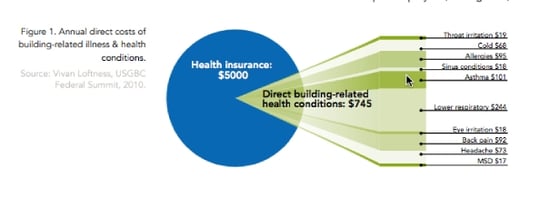Since we spend most of our time indoors compared to outdoors, the air we breathe whether at home, offices, schools or hospitals can increase the risk of health problems. There are several factors and sources of pollution that makes managing indoor air quality (IAQ) a challenge to real estate property managers and building engineers. Some of the pollutants are chemicals or gases, while others can be microbes such as mold and pests. These can cause allergies, respiratory illness such as asthma, sore throat and eyes. Other gases such as carbon monoxide can even cause death when present in high concentrations. Certain long-term conditions such as heart disease and cancer have also been associated with poor IAQ.
According to recent research, the estimated annual direct costs linked to building-related illness and health conditions are $745 per employee (see below image).

Source: Sustainable business and enterprise roundtable
Real estate property managers and owners are prioritizing IAQ and are taking steps to improve and sustain a healthy building as part of their sustainability strategy. Although office managers or corporate users, schools, universities and hospitals have a variety of good reasons to maintain IAQ, real estate owners and managers are driven by different motivating factors. For the real estate property managers/owners the main advantages of maintaining a good IAQ are improving their competitive advantage in the marketplace, ability to attract and retain high-paying tenants, mitigate regulatory risk, avoid liability due to sick building syndrome and increase the property value.
According to the US. Environmental Protection Agency, the commonly found pollutants include but not limited to “environmental tobacco smoke; asbestos from insulating and fire-retardant building supplies; formaldehyde from pressed wood products; other organics from building materials, carpet, and other office furnishings; cleaning materials and activities; restroom air fresheners; paints; adhesives; copying machines, and photography and print shops; biological contaminants from dirty ventilation systems or water-damaged walls, ceilings, and carpets; and pesticides from pest management practices”.
This list represents harmful chemicals and not only poses issues for corporate offices but also causes increasing levels of risk for buildings such as schools and hospitals.
Here we take a look at why a variety of different buildings should care about indoor air quality:
Schools
With nearly 56 million school children in US alone, where children spend a major portion of their education inside schools, IAQ is a significant concern. School children are more susceptible to pollutants than adults due to the fact that they breather higher volume of air relative to their body weight and the fact that their body is still in an active growing phase. Children are even more sensitive to higher temperatures than adults due to their high metabolic rates and higher activity levels. Hence they prefer cooler temperatures than most adults. Children are more sensitive to pollution, and children with asthma are especially sensitive. Asthma is responsible for millions of missed school days each year
All types of schools—new or old, big or small, elementary or high school—can experience IAQ problems. Since school districts are facing budget problems, the EPA has tools and techniques for schools that help schools with the best practices, guidelines and management action items to improve schools’ indoor air quality.
Maintaining a good IAQ in schools helps with the following three objectives 1. The physical well being of students 2.The cognitive and mental well-being and 3.long-term academic success and achievement.
The following is a list of important action items to consider when maintaining good IAQ in schools:
- Reduced levels of pollutants such as volatile organic matter (VOCs)
- Ensuring the absence of environmental tobacco smoke.
- Avoidance of moisture/molds in the building.
- Avoidance of allergen sources.
- Adequate cleaning and maintenance of the schools
- Good control of the maintenance of heating and ventilation
- Periodic monitoring of of the IAQ parameters
Hospitals:
It is important to maintain good IAQ within healthcare environment such as hospitals and other facilities offering healthcare since the quality of indoor air directly impacts the patients as well as caretakers within these facilities. Patient safety and comfort are the top priorities for any healthcare facility. Since patient satisfaction is measured in surveys, IAQ is a focus for every hospital these days. Another important factor is the staff at the hospital comprising of doctors, nurses and other administrators. The indoor air quality has a direct impact on their productivity as well as health and welfare. According to a study by Lawrence Berkeley National Laboratory, they found that improved IAQ improves worker productivity by 0.5% to 5%.
Indoor air quality (IAQ) is made up of a complex number of factors such as temperature, humidity, presence of chemicals and other contaminants and pollutants, and the quality of outdoor air brought inside. IAQ is also a component of sustainable concepts that are incorporated into the design of new hospitals or in case of retrofits to older hospitals. Hospitals are also rampant with hazardous materials such as radiation, chemicals and fast spreading infectious agents. In addition, patients with extreme care needs such as organ failures or cancer can be increasingly susceptible to the indoor environment.
Hence a good IAQ program is essential to assure a safe environment of care and it can be achieved if health care planners, patient care personnel, and administrators work together. The challenge remains that developing and implementing a practical and safe IAQ program can sometimes disrupt existing operations but with enough care, adequately good IAQ can be achieved.
One of the ways that hospitals can maintain IAQ is to recognize the airborne hazardous materials in critical areas and focus on curtailing those through good ventilation practices. Such airborne infection risk is minimized by providing appropriate negative pressure rooms with out-door exhausts as well as sufficient room air exchanges to help minimize employee exposure. Other measures include source management of any recognized volatile organic chemicals that can be detected using sensors. Taking engineering measures such as filtration for air, steam humidifiers and installing room alarms would be helpful in maintaining good IAQ.
Implementing an improved IAQ program is a viable goal for increasing the patient satisfaction at hospitals and other health care facilities.
Hotels:
It is becoming important for hospitality industry to adopt a good indoor air quality process in order to provide exceptional service to guests, prevent liability and increase staff’s productivity. According to a study by the international Hotel and Restaurant association, more than two-thirds of frequent travelers complain about air quality and have suffered from headaches, itchy and runny nose, sneezing, cough and sore throat as a result of staying in a hotel with poor IAQ. It is a legal responsibility for hotels to ensure the safety of staff, guests and customers at all times. This includes for example the safe functioning, adequate ventilation and proper maintenance of boilers and heating systems to avoid creating toxic fumes such as carbon monoxide.
Hotels are designed to provide comfort for guests. However, most complaints related to uncomfortable environments and poor IAQ arise. IAQ has become one of the important issues for hotel management, and audit methods are being established to identify and address the indoor air problems.
Since most guests spend their time on beds, there is a large chance for the microbes and other bacteria to be the main cause of pollutants in the rooms. The other factors are weak air exchange channels, poor ventilation, lack of insulation and sealing agents, using chemically strong cleaning agents and others.
The three important factors that are useful for a good IAQ policy are 1.identifying and eliminating the pollutant’s source 2.Filtration and air purification and 3.ventilation and dilution of contaminants.
Some of the ways to implement good IAQ process is as follows:
- Performing tests for routine air-quality indicators. Any observations made by staff or guests about internal air quality should be analyzed to see whether there are any patterns of poor air quality
- Maintaining ventilation rates
- Regular cleaning of HVAC systems
- Maintaining high standards of cleaning and hygiene
- Reducing humidity and controlling it with dehumidifiers
Conclusion:
In conclusion, poor indoor air quality is caused by a wide variety of issues such as pollutants, air borne particles, chemicals and emissions from equipment inside the building. Poor IAQ lead to many health issues such as asthma, sneezing, increase in allergies as well as long-term illness such as heart disease and cancer in extreme cases. This makes it even more important for buildings such as schools, hospitals and hotels to invest their resources in maintaining high IAQ.



